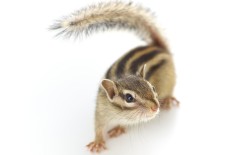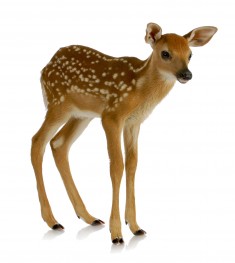Everybody wants to eat your garden – not just you, your family, friends and neighbors. Many animals that roam fields and forests, from deer to raccoons to chipmunks, view your plants as a convenient grocery store. And don’t get me started on woodchucks and raccoons.
Fences, natural repellents, blaring rock music? Which approach is the best discouragement?
Woodchucks – also called groundhogs – eat everything, the minute you put in transplants or seeds sprout. They don’t even let you look at the growing plants and get your hopes up. The Maine Department of Inland Fisheries and Wildlife website lists some of their favorite foods, including broccoli, peas, beans, carrot tops, lettuce and squash. In my neighborhood, they also have devoured cucumber and tomato plants, and they will eat flowers, too: asters, daisies, lilies, marigolds, pansies, phlox, snapdragons and sunflowers, according to the department.
In our garden this year, they have decimated the corn poppies and lettuce-leaf poppies, for the first (and I hope, the last) time.
Raccoons also are omnivorous, eating everything from roadkill to fish in the streams and clams in the ocean. The bad news for you and your garden? They also like vegetables. Unlike woodchucks, raccoons do let you get your hopes up – and then they dash them. They wait until your corn, tomatoes or peas are just about ready to be picked. Then they tear them apart – (gleefully?) eating only a small part of what they ruin.
It infuriates me to go out to the garden and find that some unknown creature has nibbled on every peach, eaten the tops off the beans (just as they started to produce) and – this is agony after waiting months for tomatoes from our garden – bitten into every last tomato, stopping only to tear up some of the vines.
SCORE 1 FOR THE RACCOONS
When it comes to raccoons, well, they have won the war in our garden. I have played rock music all night long, and I’ve tried every repellent I could find. Regardless, they always got the corn, and just to irk me, they broke the stalks to get at each ear. I finally conceded: We stopped growing corn and now buy it at one of Cape Elizabeth’s farm stands.
Deer eat vegetables, but they attack landscape plants more often. They do the most damage in winter, when the food the deer would prefer is covered in snow. That said, they go out of their way in the summer to dine on hosta, magnolia blossoms, phlox and rhododendron blossoms.
Chipmunks are everywhere in our garden, and we regularly see them sitting on one of our garden benches eating strawberries and raspberries. They are, however, small – so they don’t eat much – and cute, and a link from the Maine Yardscaping Partnership website gotpests.org says you can’t do much about them, anyway.
TELLTALE PRINTS
Richard Brzozowski, an agriculture specialist with the Falmouth office of the University of Maine Cooperative Extension, offered this plan of action for larger garden pests: once you spot damage, the first step is to figure out who is responsible. If you can’t see tracks, spread kitchen flour on the ground in the garden, so the tracks will show up. Then go online to identify the animal that’s visiting your outdoor buffet. No matter what you find, the two best solutions, he said, are to get a dog that you let roam or to put up a fence – maybe even an electric one.
“Electric netting is really effective,” Brzozowski said. “It seems to be a sizable investment at a couple of hundred dollars, but it will last 10 or 20 years if you take care of it properly.” (He suggested an Iowa company called Premier Fencing.)
Even wood or mesh fences will keep out most animals. Raccoons can climb over fences, Brzozowski said, and woodchucks can dig under them, but most of the time they don’t bother.
If woodchucks dig under a fence that goes to the ground, you can bury the chicken-wire fence at least 10 inches deep in the ground. If you don’t want to bother with digging, lay a 30-inch piece of chicken wire on the ground and install the fence on top of that, with 6 inches inside the garden and 30 inches outside, the Department of Inland Fisheries and Wildlife says.
EVEN DOG’S AROMA REPELS
Dogs repel deer, raccoons and woodchucks. Leash laws in most communities prevent you from letting the dogs run free, but if you tie them up outside, the aroma works well as a preventative.
You can also try commercial or homemade repellents, useful to keep away deer, if not so successful with other garden pests. Deer repellents work by creating a smell that deer don’t like, and can include such things as coyote urine. The department also offers a recipe for making your own (see sidebar), if you don’t have coyote urine handy. Deer eventually will get used to a spray repellent, whether homemade or store-bought, so after about a year, switch the type you use.
Moles are a problem mostly for lawns, but the department urges gardeners to think before trying to get rid of them. Instead of seeing them as a pest, consider changing your attitude, remembering that they eat a lot of insects and improve soil aeration and drainage.
Still unwilling to let moles tunnel in your lawn? Then remove the mole hills when they first appear and fill in and reseed their tunnels. Poisoning, flooding and stunning are difficult and not always effective, anyway. Also, with poisons, I’d worry about neighborhood pets, flooding seems mean, and stunning – which I think means electricity – sounds dangerous. Fortunately, we’ve never had moles in our yard. You can also try the Inland Fisheries’ department recipe for mole repellent (see sidebar).
DOUBTING TOM
In truth, I haven’t tried these recipes. I’m not much for mixing up magic potions. (I do follow label directions to mix up anti-deer sprays in my big backpack sprayer.) I also am not the type of person who collects hair from barber shops or animal fur from animal grooming shops to strew around the garden. I’ve heard that people do that sort of thing, but it always seemed unsanitary to me. And I’ve never met anyone who actually kept pests out of their gardens with fur or hair clippings.
I have met people who fenced their entire vegetable garden, with some shocking electric fencing at the bottom to keep out the small animals. That works.
Voles tunnel in lawns and chew the bark off young trees. To prevent them, a link from gotpests.org suggests keeping mulch 3 feet away from the base of your plants, because the voles can more easily tunnel through mulch than pure soil. We’ve never had voles, either, which may be because we cut down most of our perennials each fall. Bill Cullina, director of Coastal Maine Botanical Gardens, says voles love making their winter homes in standing perennials; by cutting those down, you discourage them.
I have found Havahart traps useless, unless they’re set up by a professional. Either they don’t spring and let the pest steal the bait, or they spring before the animal ever gets inside. Other traps are dangerous to pets and should be avoided.
OUTSMARTED BY A WOODCHUCK
My personal nemesis is the woodchuck. But after many years of trying, I’ve found you can get woodchucks to leave your garden. Find the holes, fill them with rocks and then soil, add used kitty litter or ammonia and keep going back.
A retired neighbor reports to me almost every evening as to where “our woodchuck” went during the day. I check for a hole and if I find one, I fill it, soak it and wait to see what the woodchuck does next. This method forces them to move elsewhere, but don’t kid yourself: They are fully capable of walking several hundred yards from their new home to feast on the delicacies in your garden.
Which is why I am glad we live less than a mile from two farm stands – where we buy the corn and any other vegetables or fruits we don’t manage to harvest before the critters do.
Send questions/comments to the editors.





Success. Please wait for the page to reload. If the page does not reload within 5 seconds, please refresh the page.
Enter your email and password to access comments.
Hi, to comment on stories you must . This profile is in addition to your subscription and website login.
Already have a commenting profile? .
Invalid username/password.
Please check your email to confirm and complete your registration.
Only subscribers are eligible to post comments. Please subscribe or login first for digital access. Here’s why.
Use the form below to reset your password. When you've submitted your account email, we will send an email with a reset code.